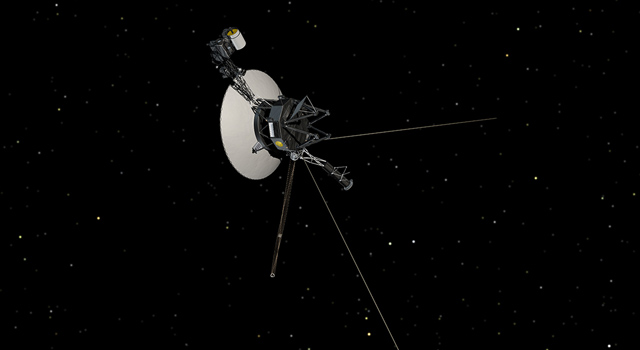News | August 18, 1989
Voyager 2 Detects Intense Radio Emissions

NASA's Voyager 2 spacecraft has detected intense radio emissions from Neptune, indicating that the planet has magnetic field.
The discovery, made by Voyager 2's planetary radio astronomy instrument team at NASA's Jet Propulsion Laboratory, Pasadena, Calif., greatly increases the likelihood that the spacecraft will discover wide range of interesting phenomena related to magnetic field, such as aurora and possible radiation-darkened ring arcs and moons around Neptune.
Voyager 2 will come within 4,850 kilometers (3,000 miles) of Neptune at 9 p.m. on Aug. 24.
The emissions are generated around planets by high-velocity, charged particles as they spiral along magnetic field lines into the planet's atmosphere.
At Neptune, "the radio emissions are very intense, very impulsive, and occur in limited range of frequency," said Dr. James Warwick, principal investigator on the planetary radio astronomy experiment. The emissions, he added, are polarized, "so we know we're dealing with magnetic field. The source is not lightning; it is related to energetic particles interacting in magnetic field."
A planetary magnetic field is girdle of magnetic field lines that surround planet. Such fields are thought to be generated by fluid motion in planet's core (molten iron in Earth's core, for example). Mercury, Earth, Jupiter, Saturn and Uranus have magnetic fields, while Venus and Mars do not. Whether Pluto has one or not is not known.
While the Neptunian radio emissions were only confirmed today, Warwick said that in looking back over Voyager data, the emissions were heard by the planetary radio astronomy instrument as early as Aug. 14. The emissions weren't immediately recognized as being associated with Neptune, however, because their character "was so different from what we were expecting," Warwick said.
As more data from the instrument is returned to Earth over coming days, Warwick's team will be able to precisely define Neptune's rotation -- the length of its day.
Early analysis indicates that Neptune's magnetic field is of an intensity similar to the magnetic fields of Earth and Uranus.
Voyager 2's close flyby over Neptune's northern hemisphere will allow the spacecraft's complement of instruments to determine Neptune's magnetic field structure and orientation.
The Voyager Mission is conducted for NASA's Office of Space Science by the Jet Propulsion Laboratory.
